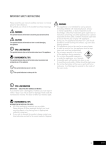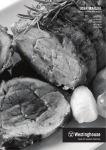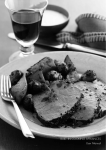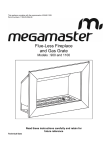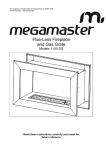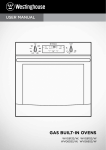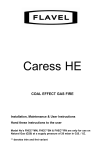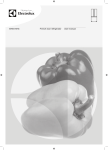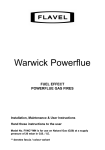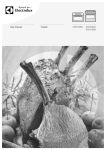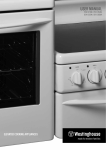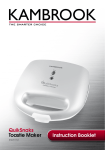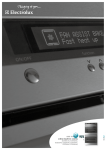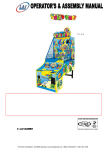Download manual
Transcript
49669GO-MN BE7900061M EN User manual 90cm Oven 2 contents 1. Important safety instructions . . . . . . . . . . . . . . . . . . . . . . . . . . . . . . . . . . . 3 2.For your safety . . . . . . . . . . . . . . . . . . . . . . . . . . . . . . . . . . . . . . . . . . . . . . . . . . . 5 3. Description of your appliance . . . . . . . . . . . . . . . . . . . . . . . . . . . . . . . . . . . . 6 49669GO-MN . . . . . . . . . . . . . . . . . . . . . . . . . . . . . . . . . . . . . . . . . . . . . . . . . . . . . . 6 BE7900061M . . . . . . . . . . . . . . . . . . . . . . . . . . . . . . . . . . . . . . . . . . . . . . . . . . . . . . 7 4. Before operating your appliance for the first time . . . . . . . . . . . . . . 8 5. Installing your oven accessories . . . . . . . . . . . . . . . . . . . . . . . . . . . . . . . . 9 6. Installing burners and trivets . . . . . . . . . . . . . . . . . . . . . . . . . . . . . . . . . . . 10 7. Getting to know your cooktop . . . . . . . . . . . . . . . . . . . . . . . . . . . . . . . . . 11 8.Using your oven . . . . . . . . . . . . . . . . . . . . . . . . . . . . . . . . . . . . . . . . . . . . . . . . . 12 9.Cooking test . . . . . . . . . . . . . . . . . . . . . . . . . . . . . . . . . . . . . . . . . . . . . . . . . . . . . 16 10.Cooking guide . . . . . . . . . . . . . . . . . . . . . . . . . . . . . . . . . . . . . . . . . . . . . . . . . . . 17 11. Dealing with cooking problems . . . . . . . . . . . . . . . . . . . . . . . . . . . . . . . . . 20 12.Cleaning your appliance . . . . . . . . . . . . . . . . . . . . . . . . . . . . . . . . . . . . . . . . . 21 13.Cleaning oven accessories . . . . . . . . . . . . . . . . . . . . . . . . . . . . . . . . . . . . . . 22 14.Catalytic liners . . . . . . . . . . . . . . . . . . . . . . . . . . . . . . . . . . . . . . . . . . . . . . . . . . 24 15.Storage compartment (selected models) . . . . . . . . . . . . . . . . . . . . . . . . 24 16.Solving problems . . . . . . . . . . . . . . . . . . . . . . . . . . . . . . . . . . . . . . . . . . . . . . . . 25 17. Installing your appliance . . . . . . . . . . . . . . . . . . . . . . . . . . . . . . . . . . . . . . . . 26 18.Wiring requirements . . . . . . . . . . . . . . . . . . . . . . . . . . . . . . . . . . . . . . . . . . . . . 33 19. Electrical & gas connection locations . . . . . . . . . . . . . . . . . . . . . . . . . 34 20. Natural gas conversion . . . . . . . . . . . . . . . . . . . . . . . . . . . . . . . . . . . . . . . . . 35 21.Testing the operation of the gas cooker . . . . . . . . . . . . . . . . . . . . . . . 36 22.Warranty . . . . . . . . . . . . . . . . . . . . . . . . . . . . . . . . . . . . . . . . . . . . . . . . . . . . . . . . . 37 for perfect results Thank you for choosing this AEG product. We have created it to give you impeccable performance for many years, with innovative technologies that help make life simpler – features you might not find on ordinary appliances. Please spend a few minutes reading to get the very best from it. Visit our website for: Get usage advice, brochures, trouble shooter, service information: www.aeg.com Register your product for better service: www.aeg.com/productregistration Buy Accessories, Consumables and Original spare parts for your appliance: www.aeg.com/shop CUSTOMER CARE AND SERVICE We recommend the use of original spare parts. When contacting Service, ensure that you have the following data available. The information can be found on the rating plate. Model, PNC, Serial Number. 3 Important safety instructions These warnings have been provided in the interest of safety. You MUST read them carefully before installing or using the appliance. The symbols you will see in this booklet have these meanings: Warning / Caution-Safety information General information and tips Environmental information This symbol indicates never to do this This symbol indicates to always do this WARNING! General warnings This appliance must not be used as a space heater. In order to avoid fire, the appliance must be kept clean and vents kept unobstructed. Do not spray aerosols in the vicinity of this appliance whilst it is in operation. Do not use or store flammable materials in this appliance storage drawer or near this appliance. Do not line the bottom of the oven with foil or cookware. Always use gloves when handling hot items inside the oven. Always turn the grill off immediately after use as fat left behind may catch fire. Do not hang any objects from the hob as it may block the air vents. Do not modify this appliance. To maintain safe operation, it is recommended that the product be inspected every 5 years by an authorised service person. Do not install an aftermarket lid or cover over this appliance. Installation, cleaning and servicing An authorised person must install this appliance (Certificate of Compliance to be retained). Before using the appliance, ensure that all packing materials are removed from the appliance. In order to avoid any potential hazard, the enclosed installation instructions must be followed. Ensure that all specified vents, openings and airspaces are not blocked. Where the appliance is built into a cabinet, the cabinet material must be capable of withstanding 85°C. Only authorised personnel should carry out servicing (Certificate of Compliance to be retained). Always ensure the appliance is switched off before cleaning or replacing parts. Do not use steam cleaners, as this may cause moisture build up. Always clean the appliance immediately after any food spillage. This appliance must be earthed. Due to the weight (freestanding 95-100kg, built in 70kg) and size of cookers, 2 persons are required to manually manoeuvre them. Remove loose items such as trivets, oven racks & trays to minimise weight. Do not use the handle to lift the cooker, instead open the oven door and lift the roof of the oven cavity. Take care when lifting to avoid any sharp edges not intended for lifting. 4 Important safety instructions WARNING! Oven During use the appliance becomes hot. Care should be taken to avoid touching the hot surfaces inside the oven. Switch the appliance off before removing the oven light glass for globe replacement. To avoid an accident, ensure that oven shelves and fittings are always inserted into the appliance in accordance with the instructions. Do not use the door as a shelf. Do not push down on the open oven door. Do not cover the grill insert with foil, as fat left there may catch fire. Always keep the grill dish clean as any fat there may catch fire. Gas cooktops Do not allow pots to boil dry, as damage to both pan and cooktop may result. Do not operate the cooktop for an extended period of time without a pot or pan on the burner. Do not allow large cookware to overhang the cooktop onto the adjacent benchtop. This will cause scorching to the benchtop surface. Do not allow cooking pots or pans to intrude into the area which is close to the controls. Ensure burner bodies and trivets are properly located. WARNING! Child safety This appliance is not intended for use by persons (including children) with reduced physical, sensory or mental capabilities, or lack of experience and knowledge, unless they have been given supervision or instruction concerning use of the appliance by a person responsible for their safety. Children should be supervised to ensure that they do not play with the appliance. During use this appliance becomes hot. Care should be taken to avoid touching hot surfaces, eg. Oven door, heating elements.. Accessible parts will also become hot when in use. To avoid burns and scalds children should be kept away. Always turn pan handles to the side or rear to prevent accidental knocking and to keep out of reach of children. 5 FOR YOUR SAFETY If you smell gas Important information for the installer • • • • • This appliance may only be installed by a LP gas installer registered with the Liquefied Petroleum Gas Association of Southern Africa. The appliance must be installed in accordance with the requirements of SANS 10087-1 and any fire department regulations and / or local bylaws applicable to the area. If in doubt check with the relevant authority before undertaking the installation. Upon completion of the installation you are required to fully explain and demonstrate to the user the operational details and safety practices applicable to the appliance and the installation. urn off gas supply at source. T Extinguish all naked flames. Do not operate any electrical appliances. Ventilate the area. Check for leaks as detailed in this manual. If odour persists, contact your dealer or gas supplier immediately. Do not tamper with the appliance. Burn-back (fire in burner tube or chamber) In the event of a burn-back, where the flame burns back to the jet, immediately turn off the gas supply at the control valve on the panel. After ensuring the flame is extinguished, wait for 1 minute and re-light the appliance in the normal manner. Should the appliance again burn back, close the control valve and call a service technician. Do not use the appliance again until the service technician has declared that it is safe to do so. Gas-pressure regulator This appliance requires an operating pressure of 2.8 kPa at the appliance. A suitable LPG regulator that complies with the requirements of SANS 1237 must be installed. Important information for the user This appliance may only be installed by a registered LP Gas installer. All registered installers are issued with a card carrying their registration number. Ask to be shown the card before allowing the installation work to commence and make a note of the Installer QCC number. Upon completion of the installation, the installer is required to explain the operational details of the appliance together with the safety instructions. You will be asked to sign acceptance of the installation and be provided with a completion certificate. You should only sign for acceptance of the installation when the installation is completed to your satisfaction. Note that your invoice is required in the event that you wish to make a guarantee claim. 6 Description of your appliance Model 49669GO-MN Freestanding gas hob with flame safeguard, programmable touch control electric oven Removable wok trivet Stainless steel splashback Removable cast iron trivet Gas burner Control panel Oven door Storage compartment Stainless steel kick panel Control Panel Programmable controler Gas hob burner controls Gas Hob Medium heat burner Intense heat wok burner Low heat burner High heat burner 7 Model BE7900061M Built-in programmable touch control electric oven Control Panel – oven programmable controller Programmable controler 8 BEFORE OPERATING YOUR APPLIANCE FOR THE FIRST TIME Setting the time The model you have purchased is fitted with a programmable timer. You MUST set the time of day before you can operate the appliance. Programmable Controller: • A fter the appliance has been electrically connected, the set clock symbol will flash on the clock display. • To set the time of day, press – or +. 5 seconds after the last change the timer arrow will disappear, confirming the time has been set. Once the time has been entered, the clock advances minute by minute. NOTE: The clock has a 24-hour display. Preparing your appliance for the first time • Please remove all internal boxes and bags from the oven before operation. • Please wipe out the oven interior prior to operation with warm soapy water and polish dry with a soft clean cloth. Do not close the oven door until the oven is completely dry. • New appliances can have an odour during first operation. It is recommended to ‘run in’ your oven before you cook for the first time. Run the oven at 180ºC for 2-4 hours and ensure that the room is well ventilated. • DO NOT line the oven with foil, it will damage the enamel. 9 INSTALLING YOUR OVEN ACCESSORIES Prior to installing accessories, remove all packaging and remove plastic film from external panels Catalytic liners Catalytic liners are coated with a specially formulated enamel coating. This porous coating enables the “self cleaning” process – see Cleaning your appliance section for more details. Catalytic liners must be installed first but you can omit them, if you wish, with no effect to cooking performance. Their sole purpose is to make oven cleaning easier. • The catalytic liners will attach to each side of your oven. There will be a left hand and right hand version. This is marked on the panel. • Position the first liner as per the diagram. The black, shiny side of the liner should be facing the oven wall, the hooks pointing down and the word ‘LH’ positioned to the top rear portion of the oven. The right hand side will be a mirror image of this. • Line the hooks up with the slots provided in the oven wall, push them in and then allow the liner to slide down to its final position. • The access hole for the side racks should be visible when the liner is correctly positioned – see diagram. Side racks The side racks that come with your oven are fitted in the following manner • Insert the 2 rear pegs into the holes provided. • Locate the front peg into the front access hole and push in firmly. Shelves and trays The shelves are designed so that they have maximum travel but cannot be accidentally pulled right out. The trays are designed in the same way and fit straight into the side racks. • L ocate the rear edge of the shelf / tray in between 2 guide rails of the side rack – see diagram. Ensure the same rail positions on both sides of the oven are being engaged. • With the front edge raised, begin to slide the shelf into the oven. • Once the indents have passed the front edge of the side rack, the shelf can be pushed completely in. • When fully inserted the shelf / tray should not interfere with the closed door. To fit a shelf or try to telescopic sides: 1.With the slides fully pushed in, push the shelf or tray along the top of the slide until it hits the back post. 2. Drop the front of the shelf or tray onto the slide ensuring it sits behind the front post of the slide. When fully inserted the shelf / tray should not interfere with the closed oven door. 10 INSTALLING burners and trivets Installing burners Installing Trivets • T he burner crown must be fitted correctly into the burner cup or damage will occur during operation. • To do this, ensure that the 2 ribs on either side of the spark plug hole are positioned into the 2 slots on the burner cup. • The burner cap is simply positioned over the top of the burner crown. • T he rubber feet on the trivets locate into the contours of the hob. • Take care when placing the trivets as dropping them may damage the hob or trivet. • The wok trivet sits on top of the trivet above the wok burner. NOTE: When the burner is correctly fitted it will sit level on the hob. Burner cap Wok trivet Trivets Burner crown Flame safeguard sensor Burner cap Burner cup Ignition spark plug Injector Wok burner Burner crown 11 getting to know your gas cooktop Using your gas hotplates Model 49669GO-MN NOTE: Gas controls turn anticlockwise from ‘Off’ and have limited movement. 2 4 Lighting burners Electronic ignition These hobs are fitted with mains powered electronic ignition. When the appliance has been connected and the power is on, depressing any knob will release sparks to all burners. To light a burner, depress the corresponding knob and while continuing to depress knob turn anticlockwise to ‘HI’ position. The knob may be released once the flame is established, and turned further anticlockwise to reduce the flame height as desired. Flame safeguard models Models with flame safeguard have the same ignition procedure as electronic ignition, but require the knob to continue to be depressed after flame is established for approximately 5 seconds. If the flame goes out when the knob is released, simply depress the knob again, this time holding it down with slightly more force for the same length of time. WARNING! • Keep hands clear of burners when lighting. • If burner does not light within 5 seconds, turn knob to ‘Off’ position, allow gas to disperse, then try lighting again. • Burners MUST be operated between ‘HIGH’ and ‘LOW’ settings only. To conserve gas, place the pan centrally over the burner and adjust the flame so that it does not go past the edge of the cookware. NOTE: In the absence of electrical power, carry out the ignition directly to the burner with a hand held ignition source. 1 3 1.Low heat burner Used for simmering with small cookware items. 2. Medium heat burner Used for normal cooking and simmering with mid size cookware items. 3. High heat burner Used for fast heating with large size cookware items. 4. Intense heat wok burner Used for very fast heating with woks and other large size cookware items. Use wok trivet provided when cooking with a wok. 12 USING YOUR oven Understanding your oven functions Rapid Heat Base Heat Function 1 Heat comes from the elements surrounding the fans as well as the smaller element above the food. This allows you to preheat your oven 30% quicker than on standard “Bake”. “Rapid Heat” is ideal for cooking frozen precooked foods such as savoury dishes, pastries, pizzas, mini meals (TV dinners), meat pies and fruit pies. Simply place the food in the oven straight from the freezer and heat – ideal for busy people. Cook in the upper half of the oven for best results. Function 4 Heat comes from the element below the floor of the oven. The Element is controlled by the thermostat and will turn on and off to maintain the set temperature. The “Base Heat” function can be used to add extra browning to the bases of pizzas, pies and pastries. Cook in the lower half of the oven when you are using only one shelf. For best results, use silver or shiny trays. Fan Assist Fan Bake Function 5 Function 2 Heat comes from the elements surrounding the fans. The fans circulate the hot air around the oven cavity so that you can put your food in different places in the oven and still cook them at the same time. You can use the “Fan Bake” function for multi-shelf cooking, reheating cooked foods, pastries and complete oven meals. It will cook at a lower temperature and be faster than baking. Please note that some variation in browning is normal. Heat comes from two elements, one above and one below the food. The fans circulate the hot air around the oven cavity so that you can put the food in different places in the oven and still cook them at the same time. You should only use a maximum of 2 shelves with “Fan Assist”. Do not use the bottom shelf. If two shelves are used, food on the shelf in the higher position will cook first and should then be removed to allow the food on the lower shelf to finish cooking. Pizza Bake / Pizza Function 6 Function 3 Heat comes from two elements, one above and one below the food. The bottom element is a clean heat element and is below the floor of the oven. Both elements are controlled by the thermostat and will turn on and off to maintain the set temperature. You can use the “Bake” function for single trays of biscuits, scones, muffins, cakes, slices, casseroles, baked puddings, roasts and delicate egg dishes. “Pizza” is a combination of “Base Heat” and “Fan Bake” and offers you the combined benefits of both functions. Heat comes from the elements surrounding the fans as well as the clean heat element below the oven floor. The “Pizza” function is ideal for foods that require cooking and browning on the base. It is great for foods such as pizzas, quiches, meat pies and fruit pies. Simply place the food in the middle of the oven and set the desired temperature. 13 USING YOUR oven (continued) Defrost Maxi Grill Function 7 The “Defrost” function uses low temperature air that is circulated by the fans. You can defrost (thaw) your food before you cook it. You can also use “Defrost” to raise your yeast dough and to dry fruit, vegetables and herbs. Fan Grill Function 10 “Maxi Grill” directs radiant heat from 2 powerful upper elements onto the food. You can use the “Maxi Grill” function for tender cuts of meat, steak, chops, sausages, fish, cheese toasties and other quick cooking foods. Grill with the oven door closed. “Maxi Grill” allows you to take full advantage of the large grill dish area and will cook faster than normal “Grill”. For best results it is recommended to preheat your grill for 3 minutes. This will help seal in the natural juices of steak, chops etc. for a better flavour. You can slide your grill dish into either of the 2 spaces within the upper pairs of support. Fast Heat Up Function 8 “Fan Grill” offers you the benefits of both “Bake” and traditional “Grill” functions. The grill element turns on and off to maintain the set temperature while the fans circulate the heated air. The oven door remains closed for fan grill. You can use “Fan Grill” for large cuts of meat to give you a result that is similar to “rotisserie” cooked meat. Put your food on a shelf in the second lowest shelf position. Put the grill dish on the lowest shelf position to catch any spills. When using “Fan Grill” it is not necessary to turn the food over during the cooking cycle. Set the temperature to 180°C. Grill “Fast Heat Up” can be selected in the initial heat up phase of any cooking function. During “Fast Heat Up” the heat comes from the elements surrounding the fans as well as the smaller element above the food. This allows you to preheat your oven 30% quicker than on standard “Bake / Pizza”. See Using your programmable controller to operate the oven instructions for more information. Cooling / Venting fan Function 9 The “Grill” directs radiant heat from the powerful upper element onto the food. You can use the “Grill” function for tender cuts of meat, steak, chops, sausages, fish, cheese toasties and other quick cooking foods. Grill with the oven door closed. Preheat your grill for 3 minutes to get the best results. This will help seal in the natural juices of steak, chops etc. for a better flavour. You can slide your grill dish into either of the 2 spaces within the upper pairs of support rails. Your built-in appliance is fitted with a cooling fan. This prevents your kitchen cabinet from overheating and reduces the condensation inside the oven. It will operate whenever you are using your oven or grill and will blow warm air across the top of the oven door. In some appliances the cooling fan may continue to operate after the appliance is turned off. It will switch off by itself once oven is cool Condensation Excess condensation may fog the oven door. This may happen when you are cooking large quantities of food from a cold start. You can minimize condensation by: • Keeping the amount of water used whilst cooking to a minimum. • Making sure that the oven door is firmly closed. • Baking custard in a baking dish that is slightly smaller than the water container. • Cooking casseroles with the lid on. NOTE: If you are using water in cooking, this will turn to steam and may condense outside your appliance. This is not a problem or fault with your oven. 14 using your oven (CONTINUED) Using your programmable controller to operate the oven Model BE7900061M Programmable controler Model 49669GO-MN Programmable controler Gas hob burner controls Setting the time of day Changing the oven temperature After the appliance has been electrically connected the “set clock” symbol will flash on the clock display. 1. To set the time of day in hours and minutes press the – or +. 5 seconds after the last change the “timer arrow” will disappear, confirming the time has been set. NOTE: The clock has a 24-hour display. 1. P ress the – or +, to decrease or increase the temperature. NOTE: The temperature can only be adjusted when the degrees symbol “°” is flashing. The temperature setting changes in increments of 5°C. To change the temperature after the degrees symbol “°” stops flashing, press the and then press the – or + to change the temperature. Change the time of day (Daylight saving) 1. Switch off the appliance by pressing . 2. Press “Timer” as many times as necessary until the “set clock” symbol and “timer arrow flash on the clock display. 3. Press “+” or “–” to change the time. 5 seconds after the last change the “set clock” symbol and “timer arrow will disappear, confirming the time has been set. Setting the oven function 1. Switch on the appliance by pressing the . The oven lights will light. 2. Press the as many times as necessary until the desired function appears. The suggested cooking temperature appears in the display and the degrees symbol “°” flashes. If the suggested temperature is not changed within approximately 5 seconds the degrees symbol “°” stops flashing and the oven begins to heat. The suggested temperature display is replaced with the oven centre temperature and a thermometer icon. The thermometer icon rises slowly, indicating the degree to which the oven is currently being heated. Setting the cooking time 1. Select the desired oven function and cooking temperature. 2. Press the timer symbol as often as necessary, until the “cook time” ❘➔❘ symbol appears. 3. Set the desired cooking time by using the – or +, whilst the “timer arrow” is flashing. After 5 seconds from the last time adjustment the “timer arrow” will disappear and your appliance is now programmed. 4. When the set time has elapsed, a signal will sound. To stop the signal, press “+” or “–”. Setting the stop time 1. Select the desired oven function and cooking temperature. 2. Press the timer symbol as often as necessary, until the “end time” ➔❘ symbol appears flashing. 3. Set the desired switch-off time using the – or + whilst the “timer arrow” is flashing. After 5 seconds from the last time adjustment the “timer arrow” will disappear and your appliance is now programmed. 4. When the set time has elapsed, a signal will sound. To stop the signal, press “+” or “–”. 15 using your oven (CONTINUED) Setting the delayed start cooking time Activating the child-proof lock The “cook time” and “stop time” functions can be combined to switch the oven on and off at a specific time during the day. 1. Select the desired oven function and cooking temperature. 2. Press timer symbol as often as necessary, until the “cook time” ❘➔❘ symbol appears. 3. Set the desired cooking time by using – or + , whilst the “timer arrow” is flashing. 4. Press timer symbol as often as necessary, until the “end time” ➔❘ symbol appears flashing 5. Set the desired switch-off time using the – or + whilst the “timer arrow” is flashing. The “cook time” ❘➔❘ and “end time” ➔❘ arrows are lit to confirm that the oven has been programmed. When the child lock is engaged, the oven cannot be switched on. 1. Switch off the appliance using the . 2. Press and – at the same time, hold until the word “SAFE” is displayed. The child-proof lock is now engaged. NOTE: When the child-proof lock function is active the time of day and minute minder can only be set. On completion of cooking When the set time has elapsed, a signal will sound for 1 minute, the oven will switch off and the remaining time indication “0.00” will appear on the display. 1. To stop the signal, press “+” or “–”. Setting the minute minder For setting a countdown period. When the period of time has elapsed, an audible signal is sounded. NOTE: This feature has no effect on the oven operation. 1. Press timer symbol as often as necessary, until the “minute minder” symbol appears flashing. Set the desired length of time using – or + whilst the “timer arrow” is flashing. After 5 seconds from the last time adjustment the “timer arrow” will disappear and the minute minder has been set. Once the set time has elapsed, a signal will sound for 1 minute. The time indication “0.00” and a flashing “minute minder” symbol will appear on the display. 2. To stop the signal, press “+” or “–”. Using FHU (Fast Heat Up) mode To quickly and efficiently preheat your oven, it is recommended to select the “Fast Heat” cooking feature. 1. Ensure the appliance is on by pressing the . The oven lights will light. 2. Select the desired oven function by pressing . 3. Set the cooking temperature by pressing the – or + to decrease or increase the temperature. NOTE: The temperature can only be adjusted when the degrees symbol “°” is flashing. The temperature setting changes in increments of 5°C. 4. Press the symbol . The letters “FHU” will appear on the temperature display. 5. When the set temperature is reached the buzzer will sound and the set temperature will be displayed. NOTE: “FHU” cannot be selected if the oven temperature is above the preset temperature. Releasing the child-proof lock 1. Press and – at the same time, hold until the word “SAFE” is cleared from the display. The child-proof lock is now released and the oven is ready to use. Beep on touch The beep sound can be activated anytime when a symbol is pressed. 1. Ensure the oven is off by pressing . 2. Press and + simultaneously for 2 seconds, a single beep will sound to confirm the operation. Repeat the above procedure to reset the beep on touch mode. As default, the beep on touch mode is off. Safety cut-out feature The oven automatically switches itself off if the temperature is not adjusted or the appliance is left operating after a period of time. The oven switches itself off after: • 20 hours when set between 30°C and 120°C • 8.5 hours when set between 120°C and 200°C • 5.5 hours when set between 200°C and 250°C Demonstration Mode – programmable controller models For display purposes, the appliance has a demonstration mode to enable demonstration of oven functionality without consuming power. In demonstration mode, the display, the light and the fan only are operational. When the appliance is in demonstration mode and the display is switched on, the clock symbol will be on. If the appliance is in demonstration mode, to operate the appliance normally the demonstration mode will need to be deactivated. To deactivate demonstration mode 1.Press symbol until the display returns to stand by mode. 2.Press simultaneously the timer symbol and “-“ for 5 seconds. 16 cooking test Get to know your new oven with this ‘Simple Test Cake’ Although we strive for a perfect performing oven, it’s possible that there will be some variation in colour when baking. Therefore, we suggest this simple, easy and delicious to make Simple Test Cake, it can help you understand your new oven. All ovens do sometimes have hot or cold spots, therefore it is important to judge with your eye as you may require to rotate during baking. ‘Simple Test Cake’ 125g butter, softened to room temperature 1 cup caster sugar 1 teaspoon pure vanilla essence 4 large eggs 2 cups self-raising flour pinch of salt 4 tablespoons (80ml) full-cream milk Method: 1.Butter base and sides of two, 20cm straight-sided round or square cake pans. Then line the base with grease proof or baking paper. 2.Preheat oven to moderate ‘180ºC’ (170ºC fan forced) and ensure oven shelf is in the centre position of oven. 3.Cream softened butter and sugar until light in colour. 4.Add vanilla essence. 5.Then eggs one at a time, beating well after each addition. 6.Sift flour and salt into the mixture and beat until well combined. 7.Add milk and beat or stir to combine. 8.Spoon mixture equally between prepared cake pans. 9.Bake in preheated oven, middle shelf for about 25 to 35 minutes or until when tested with a fine cake skewer it comes out clean or the edges of the cakes have come away slightly from the sides of the cake pans. 10.Remove from oven to wire cake rack and rest for 5 minutes before removing from cake pans. Cool completely. To Serve: sandwich together with your favourite jam or conserve, and dust top with pure icing sugar. NOTE: If desired substitute butter for either margarine or olive oil spread. Recipe is based on the standard metric 250ml cup and 20ml tablespoon sets. 17 cooking guide • F or best baking results preheat oven for 30 minutes. • Select the correct shelf location for food being cooked. • The grill tray can be used in the oven as a baking dish, except in oven shelf location 1. • Make sure dishes will fit into the oven before you switch it on. • Keep edges of baking dishes at least 40mm from the side of the oven. This allows free circulation of heat and ensures even cooking. • Do not open the oven door more than necessary. • Do not place foods with a lot of liquid into the oven with other foods. This will cause food to steam and not brown. • After the oven is turned off it retains the heat for some time. Use this heat to finish custards or to dry bread. • Do not use a lot of cooking oil when roasting. This will prevent splattering oil on the sides of the oven and the oven door. Polyunsaturated fats can leave residue which is very difficult to remove. • When cooking things which require a high heat from below (e.g. tarts), place the cooking dish on a scone tray in the desired shelf position. • For sponges and cakes use aluminium, bright finished or non-stick utensils. • Remove unnecessary trays or dishes when roasting or baking. Oven shelf location Your oven has 6 positions for shelves or grill dish carrier. These are numbered from 1 (the lowest shelf position) to 6 (the highest shelf position). See diagram. To give maximum space above and below the shelves, load them in this way: • W hen cooking with 1 shelf, use position 1 or 2. • When cooking with 2 shelves, use position 1 and 3. • When grilling use positions 4,5 and 6. Use the oven efficiently, by cooking many trays of food at the same time. For example: • Cook 2 trays of scones, small cakes or sausage rolls. 6 5 4 3 2 1 18 COOKING GUIDE (Continued) Choosing the best oven settings The following table is intended as a guide and experience may show some variation in cooking times necessary to meet individual requirements. We recommend that you preheat your oven for 30 minutes. Modes without Oven Fan Temperature •C Food Oven shelf position* Time in minutes Scones Plain or fruit 220 3 or 4 10 – 15 Biscuits Rolled Spooned Shortbread biscuits 170 190 160 3 3 3 13 – 18 13 – 18 30 – 35 Meringues Hard – individual Soft – individual Pavlova – 6 egg 110 180 110 3 3 3 90 15 – 20 75 Cakes Cup cakes Sponge – 4 egg Shallow butter cake 190 180 180 3 or 4 3 or 4 3 15 – 20 20 – 30 25 – 30 Pastry – short crust Cornish pasties Custard tart 200 200/180 3 3 40 – 45 Pastry 8/200 Whole tart 10/200 & 20/180 Pastry – choux Cream puffs 210 3 25 – 30 Yeast goods Bread 210 3 25 – 30 Temperature •C Oven shelf position* Modes with Oven Fan Food single shelf multi shelf Time in minutes Scones Plain or fruit 210 3 or 4 2&5 10 – 15 Biscuits Rolled 150 3 or 4 2&5 13 – 18 Spooned 180 3 or 4 2&5 13 – 18 Shortbread 150 3 or 4 2&5 13 – 18 Hard – individual 100 3 or 4 2&5 90 Soft – individual 165 3 or 4 2&5 15 – 20 Pavlova – 6 egg 100 3 or 4 2&5 75 Cup cakes 180 3 or 4 2&5 15 – 20 Sponge – 4 egg 170 3 or 4 2&5 20 – 30 Shallow butter cake 170 3 or 4 2&5 25 – 30 Rich fruit cake 170 3 or 4 2&5 60 Cornish pasties 180 3 or 4 2&5 40 – 45 Custard tart 190/170 3 or 4 2&5 20 – 30 Meringues Cakes Pastry – short crust Whole tart Pastry 8/190 Whole tart 10/190 & 20/170 Pastry – choux Cream puffs 200 3 or 4 2&5 25 – 30 Yeast goods Bread 200 4 2&5 25 – 30 * Counting from the bottom shelf up. 19 COOKING GUIDE (Continued) Roasting Meat Grilling GUIDE 1. Place the meat in the oven and set the temperature between 180°C and 200°C. It is recommended to wrap your meats in an oven roasting bag or foil to prevent fats and oils from splattering, making it easier to clean your oven. 2. Use the grill / oven dish and grill insert. Place the meat on the insert. 3. Do not pierce the meat, as this will allow juices to escape. 4. When the meat is cooked, take the roast out of the oven, wrap in aluminium foil and leave to stand for about 10 minutes. This will help retain the juices when the meat is carved. The table shows temperatures and cooking times for different kinds of meat. These may vary depending on the thickness or bone content of the meat. Meat Recommended temperature Beef 180°C – 200°C Lamb 180°C – 200°C Minutes per kilogram Rare 35 – 40 Medium 45 – 50 Well done 55 – 60 Medium 40 Well done 60 Veal 180°C – 200°C Well done 60 Pork 180°C – 200°C Well done 60 WARNING! NOTE: Always clean the grill / oven dish after every use. Excessive fat build up may cause a fire. Grilling is conducted with the oven door closed As a method of cooking, grilling can be used to: • Enhance the flavours of vegetables, fish, poultry and meat. • Seal the surface of the food and retain the natural juices. This table shows how to grill different types of meat: Beef Tenderloin, rump, sirloin. Brush with oil or melted butter, especially if the meat is very lean. Lamb Loin chops, short loin chops, chump chops, and forequarter chops. Remove skin or cut at intervals to stop curling. Brush with oil or melted butter. Sausages Prick sausages to stop skin from bursting. Poultry Divide into serving pieces. Brush with oil. Fish Brush with oil or melted butter and lemon juice. Bacon Remove rind. Grill flat. Guide to better grilling Roasting poultry and fish Steak 15 – 20 minutes 1. Place the poultry or fish in an oven set at a moderate temperature of 180°C. 2. Place a layer of foil over the fish for about three quarters of the cooking time. The table shows temperatures and cooking times for different kinds of fish and poultry. These may vary depending on the thickness or bone content of the meat. Chops 20 – 30 minutes Fish 8 – 10 minutes Bacon 4 – 5 minutes Poultry & Fish Recommended temperature Minutes per kilogram Chicken 180°C – 200°C 45 – 50 Duck 180°C – 200°C 60 – 70 Turkey 180°C – 200°C 40 – 45 (<10kg) 35 – 40 (>10kg) Fish 180°C – 200°C 20 Oven / grill dish with wire rack insert No definite times can be given for grilling because this depends on your own tastes and the size of the food. These times should only be used as a guide and remember to turn the food over half way through the cooking process. For better grilling results, follow these easy instructions: 1. Preheat grill for at least 5 minutes. 2. Choose only prime cuts of meat or fish. If the cut is less than 5mm thick it will dry out. If the cut is more than 40mm thick, the outside may burn whilst the inside remains raw. 3. Do not place aluminium foil under the food as this prevents fats and oils from draining away, which could result in a fire. 4. Baste the food during cooking with butter, olive oil or marinade. Grilled food is better if marinated before cooking. 5. Use tongs to turn food as a fork pierces the surface and will let juices escape. Fan Grill The “Fan Grill” assists the grilling process by circulating the heat evenly around the food. The recommended temperature setting is 180°C for all fan grilling functions. 1. Place the grill dish on the bottom rack. 2. Place meat / poultry on an oven shelf above the grill dish. 3. Wipe off any oil or fat which spatters while the oven is still warm. 20 DEALING WITH COOKING PROBLEMS (see also solving problems) Problem Causes Remedies Uneven cooking: • • • • • – Select shelf that puts food in the centre of the oven. – Experiment with other trays or dishes. – Centre trays. – Rotate food during cooking. – Remove grill dish from oven on bake modes. Baked products too brown on top: • • • • ven not preheated. O Baking tins too large for the recipe. Baking tins not evenly spaced. Products not evenly sized or spaced on trays. • Baking temperature too high. – Preheat the oven. – Use correct size tins. – Stagger baking tins at least 3cm between tins and the oven walls. – Make into same size and shape, & spread evenly over trays. – Lower the temperature. Baked products too brown on bottom: aking tins too large for the recipe. • B • Baking tins are dark metal or glass. – Use correct size tins. – Change to shiny, light tins or lower the temperature by 10°C. – Cook one shelf higher. – Don’t open the oven door until at least half the cooking time has passed. – Lower the temperature. – Remove grill dish from oven on bake modes. Incorrect shelf position. Oven tray too large. Trays not centralised. Air flow in oven uneven. Grill dish affecting thermostat. • F ood too low in the oven. • Oven door opened too frequently during baking. • Baking temperature too high. • Grill dish affecting thermostat. aking temperature too high. B Food too high in oven. Cake batter over mixed. Pan too deep. Baking pans dark. – Lower the temperature. – Cook one shelf lower. – Mix just long enough to combine ingredients. – Check size of pan and use recommended size. – Change to shiny pans. Cakes have a cracked, thick crust: • • • • • Baked products are pale, flat and undercooked: • Baking temperature too low. • Food too low in oven. • Baking time too short. – Raise the temperature. – Cook one shelf higher. – Increase cooking time. – Use correct size tin. • Baking temperature too low. • Baking time too short. • Proportions of Ingredients incorrect in the recipe. • Opening door too early in baking. – Raise the temperature. – Increase cooking time. – Check recipe. • Poor hot air circulation. • Grill dish affecting thermostat. – Elevate food onto a rack to allow air circulation. – Remove grill dish from oven on bake modes. • Incorrect tin size. Cakes fallen in the centre: Roast meat & potatoes not browning in fan oven: – Do not open the door until the last quarter of cooking time. Juices running out of meat: – Do not pierce meat with fork, turn with tongs. Grilled meats overcooked on outside & raw in the centre: – Grill at lower insert position. Grilled chops & steaks curling: – Cut into fat every 2cm (1/2”). 21 CLEANING YOUR APPLIANCE WARNING! • A lways make sure that the oven is electrically isolated before cleaning. This can be done by the functional switch nearby. • Do not line the bottom of the oven with foil or cookware. • Do not use steam cleaners. Stainless steel WARNING! • T he oven door trim, the control panel and the storage compartment are decorated with a special stainless steel that resists finger marks and should only be cleaned with warm water and a mild detergent. Do not use stainless steel cleaners, abrasive cleaners or harsh solvents on these parts. NOTE: Make sure you follow the polish or brushing lines in the stainless steel. • All grades of stainless steel can stain, discolour or become greasy. You must clean these regularly by following the procedures below if you want your appliance to look its best, perform well and have a long life. • Care must be taken when wiping exposed stainless steel edges, they can be sharp! • The stainless steel gas hob can be cleaned with stainless steel cleaners if it becomes soiled or discoloured. • A suitable cleaner can be purchased from Electrolux Customer Care Centres. Glass • G lass surfaces on doors and control panels are best cleaned immediately after soiling. • A damp cloth may help remove baked on food deposits. WARNING! • T he door glass on this appliance is made from a tough, durable material that withstands heating and cooling without breaking. However, it must be remembered that it is GLASS, it may break. Treat it accordingly! Should you have any questions about the glass in your new appliance, please contact the customer care centre. • Do not use harsh abrasive cleaners or sharp metal scrapers to clean the oven door since they can scratch the surface, which may result in shattering of glass. Gas Hotplate • T he trivets can be removed for cleaning by carefully lifting them from the hob. • Clean by washing with warm soapy water. • The burner caps and crowns are also removable for cleaning. • If the caps, crowns and cups are heavily soiled, use a non-abrasive cleaning compound. • Flame port blockages should be removed by using a matchstick or brush. • Do not clean them with abrasive or caustic type cleaners, or clean them in a dishwasher. Oven • A lways keep your appliance clean. Ensure that fats and oils do not accumulate around elements, burners or fans. • Always keep the oven dish, baking trays, grill dish and grill dish inserts clean, as any fat deposits may catch fire. • Always wrap your meats in foil or an oven roasting bag to minimise cleaning. Any polyunsaturated fats can leave a varnish-like residue which is very difficult to remove. Grill • A lways keep the grill dish and grill dish insert clean, as any fat deposits may catch fire. 22 CLEANING YOUR oven accessories Removing the trays and shelves from your appliance • S lide the dish and grill tray towards you until they reach the front stop. • Tilt them up at the front to clear the side supports, taking care not to spill the contents. • Lift them clear. • Wash the tray and shelves in hot soapy water. • Reverse the above steps to put the grill tray and shelves back again. • Ensure that they are placed between the 2 support wires. • To remove a tray from a sliding position: • Pull tray towards you until it stops. • Lift the tray clear. Cleaning your oven door The oven door has been designed to allow the two inner door glasses to be removed for cleaning without removing the door from the product. Removing the inner door glass for cleaning: • Open the door fully to gain access to the hinges • Push down the hinge locking tab as shown in the diagram on both sides of door Locking tab up – normal position Locking tab down – for cleaning Removing the side racks or shelf supports • G rasp the shelf support at the front. • Pull it firmly inwards. • G ently close the door until it stops in partially open position on the locking tab (the door will not fully close with the locking tab in the down position). • In this position the top door trim can be removed by pushing each side on the serrated surface to release the clips and lift the trim away from the door. • To remove the inner glass, tilt top of glass towards the oven and lift out. • The middle glass is removed in the same way. • The inner side of outer glass can be cleaned in-situ when inner and middle glass is removed. • Clean glass using detergent and warm water, wipe clean and dry thoroughly. Re-assembling the door glass panels: • Replace the middle glass back to the door. The middle glass is a clear pane and orientation of the glass is not important. • Replace the inner glass back to the door, ensuring the side with black ceramic paint faces away from the oven cavity when door is closed. • Fully open the door and return the locking tabs to their normal position and close the door. Door top trim Inner glass Press here on each side to release trim clips Middle glass 23 CLEANING YOUR oven accessories (continued) Cleaning your oven door WARNING! • D O NOT use the oven without the inner and middle door glass fitted. • NEVER spray any caustic cleaners on any surface of the door or damage to the surface coatings will result. • DO NOT use metal utensils, scrapers, scourers, or abrasive cleaners to clean the glass or any of the door trims. These will damage or scratch the surface coatings and degrade the finish and appearance. • DO NOT place glass in dishwasher. • Use only warm water and liquid detergent with a soft cloth to clean the glass or trims. • Before refitting the glass panes to the door ensure they are dried with a soft cloth. • The glass edges have been specially ground to remove any sharp edges. However it is glass, and should be handled carefully to avoid injury to your person and damage to the glass. WARNING! Make sure the appliance power is switched off at the isolating switch before you remove or replace parts, to avoid the possibility of electric shock. Changing the light globe • T here are 2 light globes located in the top of the oven cavity towards the front. The light globe glass is accessible between the passes of the upper element. • To remove, turn oven light glass anticlockwise. • A special high temperature resistant globe should be used. This can be purchased from the customer care centre. Light glass can be removed - turn anti-clockwise 24 CATALYTIC LINERS Operation The catalytic liners are coated with a specially formulated enamel coating, over a base of regular enamel. This enamel coating has a rough surface which is also porous. During normal cooking, fats and other food spatter is partially absorbed into the surface and then oxidised away. This oxidisation of the fat works best if the oven is set at high temperatures. If you do a lot of lower temperature baking, say around the normal 180ºC, then the cleaning process may not be complete. Every now and then you should turn the oven on to 260ºC for around one hour to completely remove the soil. Cleaning Should the panels become heavily soiled, they will need to be taken out of the oven and cleaned by hand. They should be soaked in warm, soapy water for at least 2 hours and then wiped clean with a soft cloth. WARNING! • S olid cleaning powders, creamy cleansers, caustic oven cleaners, steel wool or other scourers will ruin the catalytic surface and must NEVER BE USED. • When running the oven at 260°C to clean the catalytic liners, surfaces under these conditions will be hotter than usual and children should be kept away. Removing the catalytic liners • Remove Side Racks. • Lift the liner up to disengage the hooks. • The liners should now be free to be pulled in towards the centre of the oven. STORAGE COMPARTMENT (SELECTED MODELS) The storage compartment is accessible through the pivoting door. Unused oven racks and grill dishes can be stored here. WARNING! DO NOT store flammable or combustible items in the storage compartments. This is not a compartment for warming food. 25 solving problems Faults Further information If there is a problem with the oven and / or grill, please: When you need information, service or replacement parts or have a warranty enquiry, please contact the Customer Care Centre: • C heck the points listed below before calling for service. It may be possible to avoid a call by fixing the problem yourself – and so continue cooking. NOTE: We may charge for service even in the guarantee period if your problem is due to the causes listed below. • S outh Africa 0800 222 825, 7:45am – 5:00pm Monday to Thursday, 7:45am – 4:30pm Friday Please have the following information ready: Model, Model Number & Serial Number. This is shown on the data plate which is visible when the oven door is open. Problem Possible cause What to do Oven or grill not working Power not turned on. Household fuse blown Controls incorrectly set Circuit breaker tripped Clock not set Foil or trays on bottom of oven Switch on electricity Check fuses Reset controls Check circuit breaker Set time of day on timer Remove foil or trays Timer not in manual mode Timer not in manual mode Household fuse blown Household fuse blown Circuit breaker tripped Lamp blown or loose in socket Protective oils being removed Set timer to manual mode Set timer to manual mode Check fuses Check fuses Check circuit breaker Replace or tighten lamp Turn grill on high for 30 mins and then the oven on 220°C for 1 hour Reduce amount of water Leave oven door open after cooking This is normal Reset time of day Repeat lighting procedure and hold knob down for 5 seconds in ‘High‘ position Turn on gas supply to appliance Ensure the knob you are turning corresponds to the burner you want to light Ensure the ports in the ignition area are clean and dry Dry or clean ignition spark plugs Switch on electricity or check fuses Oven not heating enough Light and fans on continuously Oven not working Oven light not working Cooker smoking when first used Too much condensation building up when baking Smells when first using oven Timer flashing Burner will not light even though the sparker is working Too much water used when cooking Protective oils being removed Power failure or interruption Knob not held down long enough in ‘High’ position for flame safeguard to engage Gas supply valve turned off Wrong knob turned off Port blockage in ignition area Ignition spark plugs wet or dirty No spark is obtained when control Electricity supply is disconnected or knob is activated switched off Ignition spark plugs wet or dirty Flames uneven or tending to lift Flame ports blocked or wet Burner incorrectly fitted Flames not staying on when knob Knob not held down long enough in ‘High’ released position for flame safeguard to engage Knob not set between ‘High’ and ‘Low’ Dirt or spillage on flame safeguard sensor Low heat, slow cooking Incorrect cooking pot or pan being used Benchtop or knobs overheating Incorrect cooking pot or pan being used Pot or pan not located on burner properly Dry or clean ignition spark plugs Clean or dry flame ports Ensure this component is fitted correctly Repeat lighting procedure and hold knob down for 5 seconds in ‘High‘ position Knob MUST be set between these positions Clean flameguard sensor tip Refer to cooktop section for correct selection Refer to cooktop section for correct selection Ensure pot or pan is centrally located on burner NOTE: Only authorised personnel should carry out servicing. If the household fuse continues to blow, call the Customer Care Centre. In the event of a power failure the gas burners may be lit with a hand held igniter and used. Take care to avoid letting unburnt gas flow for more than 5 seconds when attempting to light the burner. 26 installation of the appliance Installing splashback (Model with hob only) 895mm 600mm 60mm Fit splashback to rear of hob with three screws provided. Cabinet requirements Model 49669GO-MN is designed to fit into a 900mm wide gap between standard kitchen cabinets. The appliance integrates with the kitchen cabinets by matching the height, depth and kick panel. The cooker may also be installed at the end of a line of benches or with a free space either side. In addition, a slot-in type installation is catered for allowing a continuous cabinetry kick panel to be used. Model BE7900061M is designed to be built into cabinetry either below a benchtop or into a vertical cabinet. WARNING! • T he cooker must be installed and serviced only by an authorised person. • A Certificate of Compliance MUST be supplied to be kept by the customer. • The packing materials must be removed before you install the cooker. • The surrounding kitchen cabinets must be able to withstand 85°C. Electrolux WILL NOT accept responsibility for damage caused by installation into kitchen cabinets which cannot withstand 85°C. • The pipes used for installation MUST have sufficient loops so the cooker can be moved for service (gas models). • The vents, openings and air spaces MUST NOT be blocked. • The anti-tilt brackets and chain or front stops MUST be installed to avoid accidental tipping (freestanding and slot-in models). • You MUST NOT lift or pull the cooker by the door handle. • The cooker MUST be checked every five years. • When setting the cooker height, ensure the top of the cooker is at least 10mm higher than the level of the benchtop. Gas hob 910mm (adjustable 910 – 930mm) 15mm (height of trivet above hob) 27 installation of the appliance (continued) Freestanding Installation To ensure cooker stability, the anti-tilt brackets must be installed, and the end of chain attached to the appliance must be placed onto hook attached to the rear wall. 600mm minimum vertical clearance from combustible surfaces 900mm minimum 600mm 755mm NOM 600mm 900mm NOM The freestanding type installation uses the appliance as supplied, and can be fitted in between cabinets, with cabinets on one side or without adjacent cabinets. There is no clearance requirement to adjacent side cabinets. 28 installation of the appliance (CONTINUED) Freestanding installation (continued) Installation of anti-tilt brackets and hook • The anti-tilt brackets must be secured to the floor at rear of cavity with an appropriate fastener according to dimensions in diagram. Hole location for hook installation C L 840mm 425mm Measurements are to be adjusted to account for the thickness of any skirting board or tiles coming between the back of the appliance and the wall 194 376 Hook • T he hook is to be secured to the back wall in the location shown above with an appropriate fastener capable of withstanding a 10kg load. • Connect services to the appliance prior to placing into cavity. • To locate appliance, slide into cavity and ensuring the rear left and right foot of appliance are captured by the anti-tilt brackets. • Before the appliance is fully pushed into position, place the chain attached to the rear of appliance onto the wall hook. Wall Appliance Chain installed 29 installation of the appliance (CONTINUED) Slot-in Installation Slot-in Conversion To convert the free standing appliance to a slot in installation the kick panel provided on the appliance is removed and the appliance is mounted on a plinth. This enables a continuous cupboard kick board to be installed, giving a more integrated appearance. There is no clearance requirement between oven and adjacent side cabinets. 600mm minimum vertical clearance from combustible surfaces 900mm minimum 755mm max 600mm This surface is to be level with the top edge of the kickboard To remove the appliance kick panel • R emove all loose parts ie. Burner crowns & caps, trivets, oven shelves. • Carefully lay down the appliance onto one side onto foam packaging and remove the screws as shown from each corner bracket. Remove 4 screws on each corner bracket 30 installation of the appliance (CONTINUED) Slot-in installation (continued) • Installation of anti-tilt brackets and stops • • • • he brackets are to be secured to the back wall T with appropriate fasteners. The bottom edge of the the brackets rest on the horizontal support surface. Two stops are to be screwed to the plinth in locations as shown (stops provided). The stops locate into slots in the base of the appliance to prevent the product from being pulled forward when installed. Measurements from the rear wall are to be adjusted if there are tiles etc. that come between the appliance and the wall. • • • • • lide cooker into position to check fitment to S anti-tilt bracket. For freestanding installation, check the height and level of the cooker. Adjust cooker feet as required. Connect gas and electrical services. Place into position. Complete Certificate of Compliance. Once services are connected, product can be lifted onto the plinth and pushed back carefully, ensuring the appliance engages into both brackets at the rear and the front stops. If the product requires removal for service, it must be lifted at the front approximately 5mm to clear the front stops prior to being pulled forward. CL 183mm + 475mm 414mm + + + Location of holes for front stops + + + + Measurements are to be adjusted to account for the thickness of any skirting board or tiles coming between the back of the appliance and the wall Front stops Installation sequence for freestanding or slot in installation • • • • • • heck that the required services are correctly C positioned (see electrical & gas services requirements). Ensure cabinetry has the correct details. Install anti-tilt brackets and chain hook or front stops as appropriate. Remove all packaging from cooker, remove all loose parts ie. Trivets, burner crowns, oven shelves. Remove plastic film from cooker. Fit splash back to cooker. 31 installation of the appliance (CONTINUED) Built-in installation Cabinet construction for built in oven For the best integration within a kitchen, install this appliance in a cupboard that gives a flush fit with the surrounding cupboard fronts. A recess of 20mm is ideal. NOTE: Your appliance must be mounted on a flat surface for the full width and depth of the product. 900mm Infill panel Cupboard door 554mm 580mm minimum 570mm 590mm 864mm Cupboard door Infill panel Oven Dimensions 572mm 552mm 586mm 596mm 895mm 32 installation of the appliance (CONTINUED) Underbench installation Vertical cabinet installation Your underbench oven looks best when the control panel is directly under the benchtop. An upper infill panel may be added if the cooktop placed above the benchtop is too deep. *Refer to cooktop installation instructions for required clearance between cooktop and oven. The oven can be built into a vertical cabinet in the same manner as an underbench. The required cavity dimensions are the same and the product is secured to the cabinet in the same way. 600mm 900mm 580mm 876mm Mounting holes NOTE: If a power point is fitted it must be accessible with the appliance installed. *See note 33 wiring requirements The cooker MUST be installed in compliance with: • local regulations, municipal building codes and other statutory regulations. Supply cord size required 49669GO-MN: 1.5mm2 BE7600061M: 1.5mm2 Data plate gives information about rating is located behind the bottom of the oven door Circuit diagram is located on the back panel of the appliance • A functional switch MUST be provided near the appliance in an accessible position. • Wiring MUST be protected against mechanical failure. • The cooker requires a means of all pole disconnection incorporated into the fixed wiring. This MUST have a disconnection gap of 3mm. • The cooker MUST be properly earthed. Connecting to services and commissioning This appliance must be installed by an authorised person, according to all codes and regulations of: • Electrical supply authorities. • Building regulations. • Local government and council authorities. Hard wiring detail 1.Remove terminal cover plate from rear panel of appliance. 2.Fit wires through hole in cover plate and make connections to terminals. 3.Engage wires into plastic clip. Secure plastic clip with two long silver screws (supplied in separate bag). 4.Replace cover plate onto rear panel. NOTE: When connections are made to a multi-phase 230 / 240V supply, the bridge piece MUST be removed from between the active connections. Before you cook in your new oven it is important that the protective oils used in the manufacture of the product be removed. • M ake sure that the room is well ventilated (to allow smoke to escape). • Run the grill on high for 30 minutes without grill dish. • Then run the oven on 220°C for 1 hour. Plastic clips Plastic clip Securing points Electrical connection location – model BE7600061M 113 Entry point of electrical cable 99 34 ELECTRICAL & GAS CONNECTION LOCATIONS Model 49669GO-MN 168mm Checking piping size To work out a suitable pipe size for connection use: The information in this table. Gas type Gas connection point to regulator 49669GO-MN 411mm 806mm Electrical cable entry point Electrical connection cable 95mm installing the gas cooker Gas pressures The following table shows the supply and operating pressures for various gases. Gas type Supply pressure lpg NG 2.8 (kPa) 2.0 (kPa) * If the regulator is placed upstream of the cooker inlet, as is normal for cookers operating on LPG, then the supply pressure and operating pressure are the same. The following table shows the injector sizes for each burner. lpg NG Low heat burner Injector orifice 0.55mm 0.70mm Medium heat burner 0.70mm 0.96mm High heat burner 1.90mm 1.19mm Intense heat wok burner 1.00mm 1.46mm lpg NG 1013.3 g/h 47.5 MJ/h Information about the length of run, number of elbows, tees and bends, the available service pressure and the supply requirements. Gas Connection Read these points before connecting to the gas supply: he appliance is preset LPG use. If natural gas is • T to be used see Conversion to natural gas section. • Gas installation must be made in accordance with SANS10087-1, the local gas fitting regulations, municipal codes and other statutory regulations. • The gas connection point is a ½” BSP external thread located at the rear of the appliance as shown. • A regulator must be fitted to the appliance. Ensure that when fitted the pressure test point of regulator is accessible. • The regulator is to be fitted to the appliance connection point, then fit hard piping from the regulator to the consumer hard piping. Ensure the installation allows the withdrawal of the appliance. 35 Natural gas conversion Model 49669GO-MN This appliance is supplied set up to for LPG usage. A conversion kit is included with the product for natural gas usage. The conversion kit contains 6 injectors and natural gas sticker. Please follow the procedure below if a conversion to suit natural gas is required. 1.Remove the hotplate trivets, burner caps and burner crowns to access the hotplate injectors. Replace the factory fitted injectors with the appropriate injectors, as supplied. Refer to injector orifice table for injector sizes. The injector size is stamped on the side of the injector. 2.Turn on the gas supply and at each new connection check for leaks using soapy water: each hotplate valve should be turned on, one at a time, and the injector hole blanked off for several seconds. 3.One by one, turn the knobs to minimum and adjust the bypass screw (accessible when the knob is removed) until a small stable flame results. Turn the knob to maximum and then back to minimum to ensure that the correct minimum flame is maintained. 4.Attach the natural gas sticker to the cooker, near the gas supply inlet. Cover the LPG label that is factory fitted. Flame size adjusted to maximum Flame size adjusted to minimum Bypass screw Control knob shaft 36 testing the operation of the gas cooker NOTE: You MUST test the cooker after installation, before you hand it over to the customer. You MUST have a manometer and a connecting tube. Checking gas supply 1.Turn on the gas supply and the electricity and try to ignite the gas. NOTE: It will take additional time to light the gas for the first time as air needs to be purged from the pipes. Testing the cooker features • O bserve the flame appearance on each burner. If it is much smaller or larger than expected, then the injector size needs checking. NOTE: When flame is unsatisfactory, then refer to the Electrolux Technical Publications and correct the fault, if possible. When maximum flame appearance is correct, then check the turn-down setting on each burner. If the settings appear to be incorrect, proceed as follows: 1.Adjust the bypass screw mounted on the body of each hotplate control cock. This is accessible when the control knob and the control panel are removed. 2.Check the ignition on all burners both separately and in combination. 3.Check the operation of the electrical components, if applicable. 4.If you are satisfied that the cooker is operating correctly, then turn it off and show the customer how to use it. Make sure you ask the customer to operate the clock and controls. NOTE: If the cooker cannot be adjusted to perform correctly, then inform the customer of the problem and put a warning notice on the cooker. If the problem is dangerous, then disconnect the cooker. If there is a fault, then the customer should be advised to contact the manufacturer’s local service organisation. 37 WARRANTY South Africa For South African 3 year warranty conditions please contact Electrolux Customer Helpline, 0800 222 825 or download from our website www.aeg.co.za, Service & Support tab. ECN: 13A086B Part No. 0342-001-614 Rev. B © 2013 Electrolux Home Products Pty Ltd ABN 51 004 762 341 AMAN_90cm_Cook_UM_Jul13






































